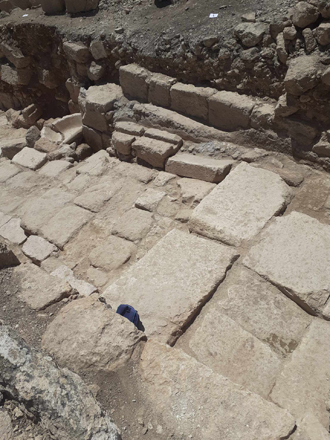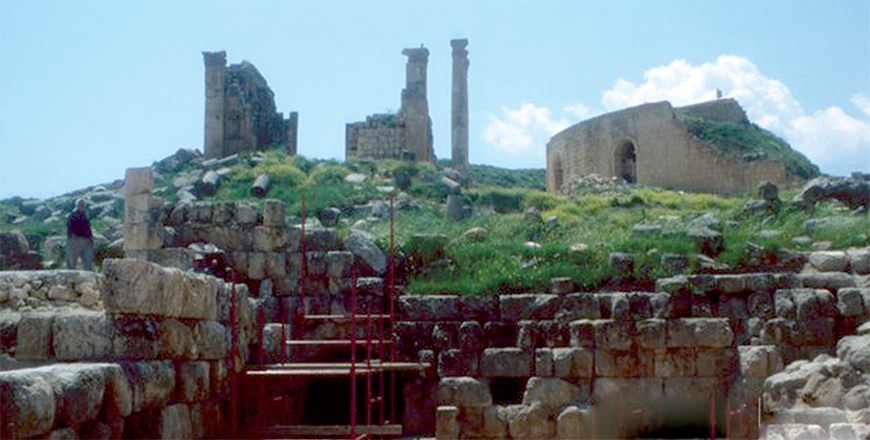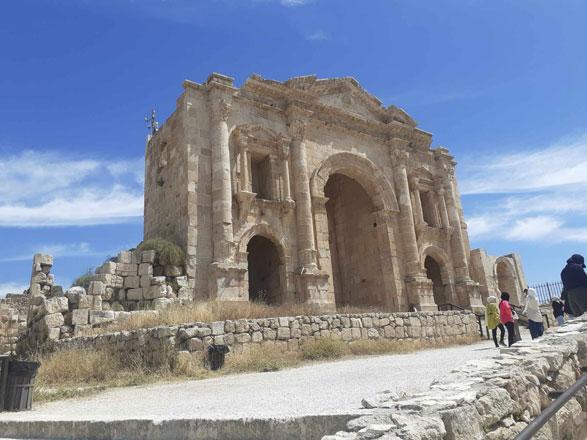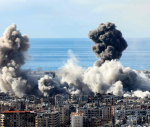You are here
Jerash North Theatre study highlights Roman odeion design, inscriptions, later structural additions
By Saeb Rawashdeh - Nov 26,2024 - Last updated at Nov 26,2024

The stage of the North Theatre in Gerasa, built during the heyday of the Roman Empire (Photo by Saeb Rawashdeh)
AMMAN — In the 1980s Australian, British and American teams were active in Jerash at the remains of the North Theatre (168 AD-230 AD). It is one of three Roman theatres in ancient Gerasa and the structure is located south of the north decumanus, west of the north tetrapylon.
The first step back then was to fully document the extant structure, including recording the positions of all the fallen stones. A full measured survey of the theatre was carried out, together with a photographic survey and a detailed structural report of necessary repair and consolidation work.
"A number of inscriptions carved in various places on the seat stones of the lower cavea [the curved part of the theatre in which spectators sat], have been interpreted as denoting the names of various municipal groupings, indicating that the odeion perhaps doubled as a council chamber at the time," said Susan Balderstone from Australian Institute of Archaeology.
Balderstone added that other inscriptions found in the portico area form part of the one on the standing portico architrave and can be dated to 230 AD.
Several factors in the construction of the auditorium indicate that it was built in two stages and had some alterations made to its original form, Balderstone continued, noting that it is possible that the additions and alterations were made at the time of the later inscription.
"It appears that the theatre in its original function as an odeion existed only to the height of the top of the praecinctio [the broad landing running around the theatre between each tier of seats] cornice, and that the upper cavea and internal vaulted passage which supports it were added later, Balderstone said.
"A significant point about the design of the theatre which reinforces this theory is the nature of the praecinctio," Balderstone explained, adding that it can be seen in other Roman theatres which have a praecinctio, such asthe RomanTheatre in downtown Amman, and the South Theatre at Jerash.
It was designed to fulfill Vitruvius's rule that a line drawn from the lowest to the highest seat will touch all the top edges and angles of all the seats, thus allowing clear passage for the voice.
However, at the north theatre this is not the case.
The praecinctio wall is unusually high, due to the need for head clearance through the doorways of the internal vomitoria (the entrances to the theatre which lead to the places where the people sat), and the thickness of the lintels (a horizontal support of timber, stone, concrete, or steel across the top of a door or window).
"The extreme west vomitorium is almost complete, with lintel and architraves still in place. Steps lead up from just inside the doorway to the south to vie access to the upper cavea," Balderstone highlighted, adding that this may be another indication that the vaulted passage and upper cavea are a later addition to the original structure.
In the north theatre at Jerash the existence of several shallow round holes averaging "20cm in diameter in seat stones of both the upper and lower cavea, forming straight lines parallel to the diameter of the auditorium", suggests that there were internal supports, Balderstone pointed out.
Excavations of the stage and stage building have exposed the scena frons.
"The stage floor was apparently timber, supported on beams recessed into the base of the scena at the rear and the pulpitum at the front. The central doorway in the north wall of the stage building has been blocked, perhaps at the same time as the building of the upper cavea, and has a fresco painted on the side facing the audience," Balderstone said.
Related Articles
AMMAN — After 2022, the French archaeological team led by the Director of the French Institute of the Near East (Ifpo), Julie Bonneric, cond
AMMAN — When the Roman Emperor Hadrian visited Gerasa (ancient Jerash) in 129/130 AD, the Roman Empire was at its peak.
AMMAN — In the 1st century BC and 1st century AD, Gerasa (modern Jerash) had operational quarries, which are types of open-pit mines used fo


















